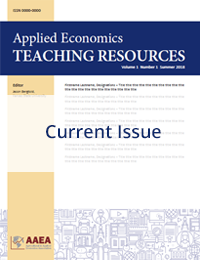Teaching and Educational Methods
Facilitating Higher Order Learning: Examining Student Outcomes after a Course Redesign
Anna Josephson(a), Larry DeBoer(b), Dave Nelson(b), and Angelika Zissimopoulos(c)
(a)University of Arizona
(b)Purdue University
(c)University of Chicago
JEL Codes: A20, A22
Keywords: Active learning, Bloom’s taxonomy, high-order taxonomy, macroeconomics, undergraduate instruction
First Published Online: March 29, 2020
Volume 2, Issue 2
Abstract
We study student learning outcomes following the redesign of an undergraduate macroeconomics course. Changes were made to focus students’ learning efforts and time in-class on the application and analysis of key concepts. To evaluate changes to student learning outcomes, we use thirteen questions that appeared on final exams both before and after the redesign. The analysis shows that after the redesign student performance on application and analysis questions improved, while performance suffered on memorization and understanding questions. With this paper, we provide a description of our experience and method for others to use in assessing changes in performance after redesigning a large, introductory-level course.
References
Allgood, S., and A. Bayer. 2017. “Learning Outcomes for Economists.” American Economic Review 107(5):660–664.
Anderson, L.W., D.R. Krathwohl, and B.S. Bloom. 2001. A Taxonomy for Learning, Teaching, and Assessing: A Revision of Bloom’s Taxonomy of Educational Objectives. Boston, MA: Allyn & Bacon.
Athanassiou, N., J.M. McNett, and C. Harvey. 2003. “Critical Thinking in the Management Classroom: Bloom’s Taxonomy as a Learning Tool.” Journal of Management Education 27(5):533–555.
Bonwell, C.C., and J.A. Eison. 1991. “Active Learning: Creating Excitement in the Classroom.” ASHEERIC Higher Education Report (1): George Washington University, Washington D.C.
Brooks, T.B., and A.W. Khandker. 2002. “A Cooperative Learning Lab: Does the Form Matter?” Contemporary Economic Policy 20(3):330–338.
Calkins, S., and G. Light. 2008. “14: Promoting Learningâ€Focused Teaching Through a Projectâ€Based Faculty Development Program.” To Improve the Academy 26(1):217–229.
Cashin, W.E. 2010. “Effective Learning.” IDEA Paper #46. http://ideaedu.org/wp- content/uploads/2014/11/IDEA_Paper_46.pdf
Caviglia-Harris, J. 2016. “Flipping the Undergraduate Economics Classroom: Using Online Videos to Enhance Teaching and Learning.” Southern Economic Journal (March).
Coil, D., M.P. Wenderoth, M. Cunningham, and C. Dirks. 2010. “Teaching the Process of Science: Faculty Perceptions and an Effective Methodology.” CBE Life Sciences 9:524–535.
DeNeve, K.M., and M.J. Heppner. 1997. “Role Playing Simulations: The Assessment of an Active Learning Technique and
Comparisons with Traditions Lectures.” Innovative Higher Education 21(3):231–246.
Freeman, S., S.L. Eddy, M. McDonough, M.K. Smith, N. Okorafor, H. Jordt, and M.P. Wenderoth. 2014. “Active Learning Increases Student Performance in Science, Engineering, and Mathematics.” PNAS 111(23):8410–8415.
Goffe, W.L., and D. Kauper. 2014. “A Survey of Principles Instructors: Why Lecture Prevails.” The Journal of Economic Education 45(4):360–375.
Hawtrey, K. 2007. “Using Experiential Learning Techniques.” The Journal of Economic Education 38(2):143–152.
Henderson, C., and M.H. Dancy. 2007. “Barriers to the Use of Research-Based Instructional Strategies: The Influence of Both Individual and Situational Characteristics.” Physical Review Special Topics-Physics Education Research 3(2):020102.
Hurney, C.A. 2012. “Learner-Centered Teaching in Nonmajors Introductory Biology: The Impact of Giving Students Choices.” The Journal of Microbiology and Biology Education 13(2):133–141.
Jensen, E.J., and A.L. Owens. 2011. “Pedagogy, Gender, and Interest in Economics.” The Journal of Economic Education 32(4):323–343.
Johnson, V.B., and B.B. Swan. 1961. “Cult of Content.” Educational Leadership 19:118–121.
Johnston, C.G., R.H. James, J.N. Lye, and I.M. McDonald. 2000. “An Evaluation of Collaborative Problem Solving for Learning Economics.” Journal of Economic Education 31(Winter):13–29.
Josephson, A., L. DeBoer, D. Nelson, and K. Zissimopoulos. 2019. “Learning to: Facilitating Practice in a Large Introductory Macroeconomics Course.” Journal of Economic Education 50(2):142–156.
Knight, J.K., and M.K. Smith. 2010. “Different but Equal? How Nonmajors and Majors Approach and Learn Genetics.” CBE Life Sciences Education 9(1):34–44.
Lage, M.J., G.J. Platt, and M. Treglia. 2000. “Inverting the Classroom: A Gateway to Creating an Inclusive Learning Environment.” The Journal of Economic Education 31(1):30–43.
Miller, C.J., and M.J. Metz. 2014. “A Comparison of Professional-Level Faculty and Student Perceptions of Active Learning: Its Current Use, Effectiveness, and Barriers.” Advances in Physiology Education 38(3):246–252.
Myers, C. 2008. “Divergence in Learning Goal Priorities Between College Students and Their Faculty: Implications for Teaching and Learning.” College Teaching 56(1):53–58.
Nguyen, T., and A. Trimarchi. 2010. “Active Learning in Introductory Economics: Do MyEconLab and Aplia Make Any Difference?” International Journal for the Scholarship of Teaching and Learning 4(1).
Onosko, J.J. 1991. “Barriers to the Promotion of Higher-Order Thinking in Social Studies.” Theory & Research in Social Education 19(4):341–366.
Prince, M. 2004. “Does Active Learning Word? A Review of the Research.” Journal of Engineering Education (July):223–231.
Roach, T. 2014. “Student Perceptions toward Flipped Learning: New Methods to Increase Interaction and Active Learning in Economics.” International Review of Economics Education 17(September):74–84.
Rovinelli, R.J., and R.K. Hambleton. 1977. “On the Use of Context Specialists in the Assessment of Criterion-Referenced Test Item Validity.” Dutch Journal of Education Research 2:49–60.
Scully, D. 2017. “Constructing Multiple-Choice Items to Measure Higher-Order Thinking.” Practical Assessment, Research and
Evaluation 22(4):1–13.
Sundberg, M.D., and M.L. Dini. 1993. “Science Majors v. Nonmajors: Is there a Difference?” Journal of College Science Teaching 22(5):299–304.
Watts, M., and W.E. Becker. 2008. “A Little More than Chalk and Talk: Results from a Third National Survey of Teaching Methods in Undergraduate Economics Courses.” The Journal of Economic Education 39(3):273–286.
Watts, M., and G. Schaur. 2011. “Teaching and Assessment Methods in Undergraduate Economics: A Forth National Quinquennial Survey.” The Journal of Economic Education 42:273–286.
Winkelmes, M.A. 2013. “Transparency in Teaching: Faculty Share Data and Improve Students’ Learning.” Liberal Education 99(2).
Yamarik, S. 2007. “Does Cooperative Learning Improve Student Learning Outcomes?” Journal of Economic Education 38(3):259–277.
Articles in this issue
Teaching Information Literacy: A Case Study of the Ripple Effect in Teamwork
Christiane Schroeter, Lindsey Higgins, Hannah Hank, and Caitlin Stevenson
Facilitating Higher Order Learning: Examining Student Outcomes after a Course Redesign
Anna Josephson, Larry DeBoer, Dave Nelson, and Angelika Zissimopoulos
Hedging with Futures: An Experiential Learning Game
John Michael Riley
Using Data Analytics and Decision-Making Tools for Agribusiness Education
Matthew S. Elliott and Lisa M. Elliott
Personalizing Online Classes: The Use of Evaluation and Participation Tools
Luis Pena-Lavano
The Do Now: A Simple, but Effective Active Learning Strategy
LaPorchia A. Collins


